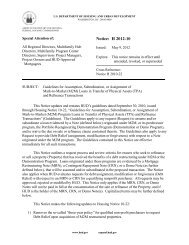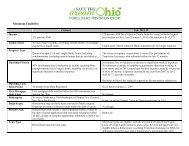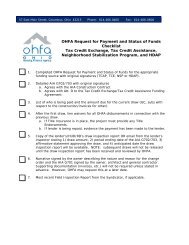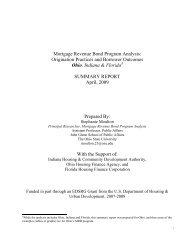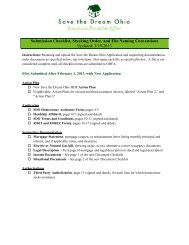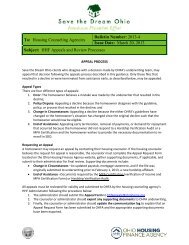lis 217 stemming the tide - LISC
lis 217 stemming the tide - LISC
lis 217 stemming the tide - LISC
- No tags were found...
Create successful ePaper yourself
Turn your PDF publications into a flip-book with our unique Google optimized e-Paper software.
Over <strong>the</strong> past few years, new federal tools andprograms have emerged to help advocates preserveHUD-subsidized properties. Theseinclude:• Mark-Up-to-Market• Mark-Up-to-Budget• IRP Decoupling• IRP Pooled Loans and Grants• Enhanced Vouchers• Mark to Market Incentives; and• Technical Assistance Grants(ITAG and OTAG)These tools are designed to address differentaspects of <strong>the</strong> preservation problem and aretailored to different market circumstances. Theymay have overlapping applications, as well asconflicting regulatory requirements. The precedingchart outlines each program’s goal, itsprogrammatic and regulatory structure, itsutility for housing preservation, and itssuitability to market conditions.This chapter will discuss <strong>the</strong> structure andrequirements of each program and outline <strong>the</strong>associated transaction issues. 10 Proforma examplesillustrate how <strong>the</strong> tools can be used tofacilitate a preservation purchase transaction.1. MARK-UP-TO-MARKET: FOR-PROFITAND LIMITED DIVIDEND OWNERS 11This program provides incentives to for-profitowners with below-market rents to remain in<strong>the</strong> Section 8 program. It is a preservation toolfor properties in strong or rising markets. Under<strong>the</strong> terms of <strong>the</strong> Mark-Up-to-Market program,rents may be marked up to comparable marketrents, which are capped at 150 percent of <strong>the</strong>Section 8 Fair Market Rent (FMR) but can behigher with a HUD waiver.Mark-Up-to-Market is available only after <strong>the</strong>project's original pre-MAHRA subsidy contracthas expired. 12 Once <strong>the</strong> owner has renewedunder MAHRA, <strong>the</strong> owner may seek to mark uprents at any time, even during <strong>the</strong> term of <strong>the</strong>new post-MAHRA contract. If a pre-MAHRA contractis still in effect, <strong>the</strong> owner must wait until<strong>the</strong> end of <strong>the</strong> contract term. Mark-Up-to-Market is one of six options available to ownersof projects with expiring Section 8 contracts, asdescribed in Chapter 3 of HUD’s "Section 8Renewal Policy" guidebook. 13EligibilityA project is automatically eligible for Mark-Upto-Marketif it meets all of <strong>the</strong> followingconditions:• It has comparable market rents at or above100 percent of FMR;• It has a HUD REAC 14 score of at least 60, withno urgent health and safety violations; and• It has no low- or moderate-income use restrictionsthat cannot be unilaterally terminatedby <strong>the</strong> owner. Examples include HUD FlexibleSubsidy 15restrictions, ELIHPA or LIHPRHA use restrictions,and local zoning or urban renewalrestrictions. The owner must certify that nosuch restrictions exist.A property that does not qualify automatically,or needs rents beyond <strong>the</strong> 150 percent FMR cap,may be eligible for Mark-Up-to-Market on a discretionarybasis, with approval from HUD headquarters.The property may qualify if it meetsany one of <strong>the</strong> following conditions:• It has a vulnerable tenant population—atleast 50 percent elderly, disabled, or large(five-plus person) families;• It is located in an area with a vacancy ratebelow three percent, where vouchers are difficultto use; or• It constitutes a high priority for <strong>the</strong> local community,as demonstrated by a contribution ofstate or local funds, such as tax abatementsor rehab grants.For projects with low- or moderate-income userestrictions, HUD will permit rents to be markedup only to <strong>the</strong> use-restricted level and will typicallyrenew <strong>the</strong> contract for <strong>the</strong> remaining termof <strong>the</strong> use restriction. In a Section 236 projectwith Flexible Subsidy, for example, <strong>the</strong> maximumrents would be 30 percent of 80 percent of <strong>the</strong>area median income, adjusted for family size.If a Section 236 or 221(d)(3) BMIR project is noteligible for prepayment, <strong>the</strong>n it is not eligiblefor Mark-Up-to-Market. Ineligible projectsinclude properties with original nonprofit ownersand some Flexible Subsidy projects which9chapter two: Federal Preservation Tools 9



